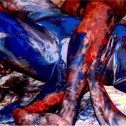A picture speaks a thousand words
I’d like to make a link between two of my favourite things in life: photography and language. The phrase “a picture speaks a thousand words” travels a long way.
One of my first memories of teaching English as a foreign language in France was the enthusiasm kids in the classroom showed when presenting them with photographs. It triggered discussion, questions and even laughter, all vital elements in a healthy and successful learning environment. I think it was a more memorable experience than the average textbook-lesson too. Relating themes and discussions to the expression of our own personal experiences makes language learning a relevant activity: sharing those experiences with other people from different places is where the motivation factor comes in. We all take photographs and the beauty of it is being able to share them with other people, from any culture, almost like a universal language that is symbolic and anthropological. Think about the power of pictures for a moment: when learning a new language or moving to a new country without any language preparation (it happens in some cases), signs, symbols and images can be the only way of being universally-understood. I must add here that I make an exception for international road signs as even they have their fair share of false friends!
Photographs are so often shared online through social media, blogs and websites. Pictures not only serve as an educational aid in language learning, but the effectiveness of picture-power in vocabulary memorisation has been proven time and time again – we simply remember pictures more than we do text: without getting too cognitively technical, our brains simply operate visually in many respects. Take the successes of mind-mapping in memorisation techniques for example. Cue cards with vocabulary on one side and a picture on the other are a typical example of common language games used in the classroom….and they work.
Why I bring photography into all of this though, is that photos are a common denominator between one person and the next, the world over. We take pictures on holiday and indeed abroad, we take family photographs, we photograph special occasions, national holiday celebrations and traditions dating back to ancient rituals. Photos therefore reflect a country’s culture and way of life.
I remember exchanging photos with my students from Japan to explore each other’s cultures: it revealed so much about social occasions, personalities, everyday lives and had us learning new words (nouns and verbs in particular) as we recalled stories and past events. What was great about it was that we ended up using the past, present and even future tenses, an all-round winner for language practise. We went on to compare and contrast traditions using superlatives and comparatives. Language-exploration aside, we gained a mutual insight into what each others’ countries were really about.
This is one of the reasons why I love photojournalism so much; it’s a type of news-reporting and indeed it is useful to speak the language on location, but the images are universal and the captions will each be translated differently in each country according to the interpretation of it or the message conveyed. You can try this discussion with foreign friends: express in the target language what a picture means to you and why and invite your foreign conversation partner to do the same. A picture can tell a story: what’s yours?
Send your photos to me from all around the world with an interesting caption about life in your country and I will pick the best one to feature next week!
Send your photos with captions in your language to: guru@theculturecave.com
© Gabriella White – The Culture Cave 2011. All rights reserved









